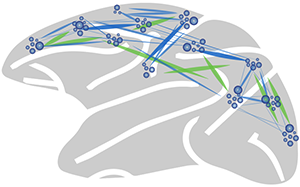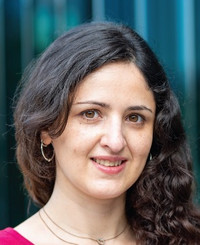Welcome to the Embodied Cognition Group (ECG)
As part of the CRC 1528 consortium, the "Embodied Cognition Group", headed by Dr. Neda Shahidi, was established as an early career research group. We aim to understand the cortical basis of ecologically relevant decision making. In particular, examining the dynamics of neural populations, involved in planning goal-directed behaviors, as well as understanding how the general physiological state of beings impacts the quality of their decisions. We are a member of Cognition of Interaction consortium (CRC1528).
Computational Models of naturalistic brain and body

For decades, the field of neuroscience has greatly benefited from conducting experiments in meticulously controlled environments. This is because the brain's interaction with the outside world is highly complex and the effect of one environmental variability is likely to be confounded by many others. Therefore, classically, neuroscientists probe the brain in repeated and carefully timed conditions, allowing a few variables at a time. Increasing the number of variables, one needs an exponentially higher amount of data to maintain the statistical power, a concept known as the curse of dimensionality. With recent advances in data-driven modeling and high-throughput computing, processing large amount of high-dimensional data in a reasonable time is feasible. Additionally, recording many channels of brain and body activity allows us to study neural correlates of ecologically valid behavior. As the animals' decision process continuously unfolds, we aim to understand the aspects of the decision-making taking place, such as when to decide, where is the animal, and which option was chosen. We identify computational components in cortical areas that are representing this process within the high-dimensional space of the activities of anatomical units, a.k.a. spiking neurons. Findings from this research will bring us closer to understanding successes and failures of decision making in real-life scenarios.
Ongoing projects
- “Predicting the time of choice in macaques in a dyadic foraging task with a human partner”; with Zahra Yousefi (Postdoctoral Researcher at the German Primate Center)
- “Predicting Lemur’s social foraging success using recurrent neural networks”; Numa Koudsie (M.Sc. program in physics, University of Göttingen), in collaboration with Claudia Fichtel and Fabian Sinz
Related publications
- Shahidi, Parajuli, Franch, Schrater, Wright, Pitkow, and Dragoi (2024) “Population Coding of Strategic Variables during Foraging in Freely-Moving Macaques.” Nature Neuroscience 27, 772-781doi: 10.1038/s41593-024-01575-w
- Milton, Shahidi, and Dragoi (2020) “Dynamic States of Population Activity in Prefrontal Cortical Networks of Freely-Moving Macaque.Nature Communications 11, 1948 doi: 10.1038/s41467-020-15803-x
Cortical representations of vigilance and active sampling

Surviving in the wild requires that primates stay aware of their surrounding while focusing on goal-directed activities. We aim to identify and experimentally alter the state of vigilance, defined as the degree to which an individual seeks information from their surroundings, in macaques and humans. We track postures and eyes of subjects in controlled environments to quantify the degree to which they actively sample information from their surrounding, then use computational models to infer their stable yet dynamic inner states, driving this behavior. In macaques, we investigate how the natural states of vigilance are represented in frontal and parietal cortical circuits and influence foraging behavior. Findings from this project will help explain how cortical representation of inner states interacts with task-relevant representations within the same neural population and explain natural variability in overt behavior. Related projects: CRC1528
Ongoing projects
- "Neural correlates of active sampling and vigilance in macaques”; Sara Ahmadi Majd (University of Göttingen)
- “Predicting macaques’ choices in a dyadic foraging task with a human partner”, with Kacper Ksiezak (M.Sc. program in data science, University of Göttingen), in collaboration with Fabian Sinz
Related publication
- Ksiezak, Burghardt, Shahidi, Gail, and Sinz (2023) "Predicting choices in a dyadic foraging task using gated recurrent networks", extended abstract for Complex Networks 2023 544-549
The role of cortico-cortical communication in cognition and perception

Complex decision-making requires orchestrated activity across many brain areas that are representing external or internal information. Using state-of-the-art electrophysiological devices, we simultaneously probe multiple brain areas, each at many sites. We identify precisely timed coordinated activity across recorded areas to identify their role in decision making
Ongoing project
- “Investigating Inter-area covariance in primates’ frontoparietal network via latent space modelling”; René Burghardt (M.Sc. program in data science, University of Göttingen), in collaboration with Fabian Sinz and Alexander Gail
Related publication
- Shahidi, Andrei, Hu, and Dragoi (2019) “High-Order Coordination of Cortical Spiking Activity Modulates Perceptual Accuracy.” Nature Neuroscience 22, 1148-1158 doi: 10.1038/s41593-019-0406-3
Project team
Neda Shahidi
(Project leader)
University of Göttingen
Contact
Homepage
Sara Ahmadi Majd
(PhD student)
University of Göttingen
Contact
Renè Burghardt
(Master student)
University of Göttingen
Kacper Ksiezak
(Master student)
University of Göttingen
Numa Koudsie
(Master student)
University of Göttingen


